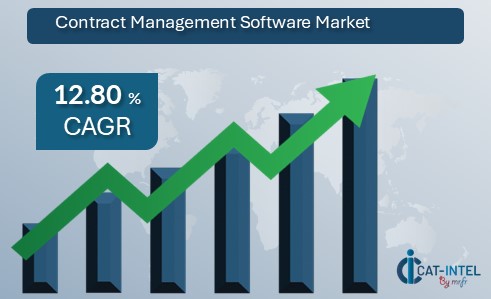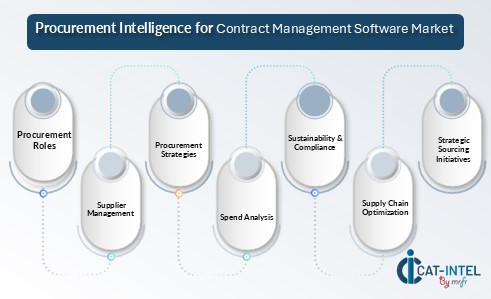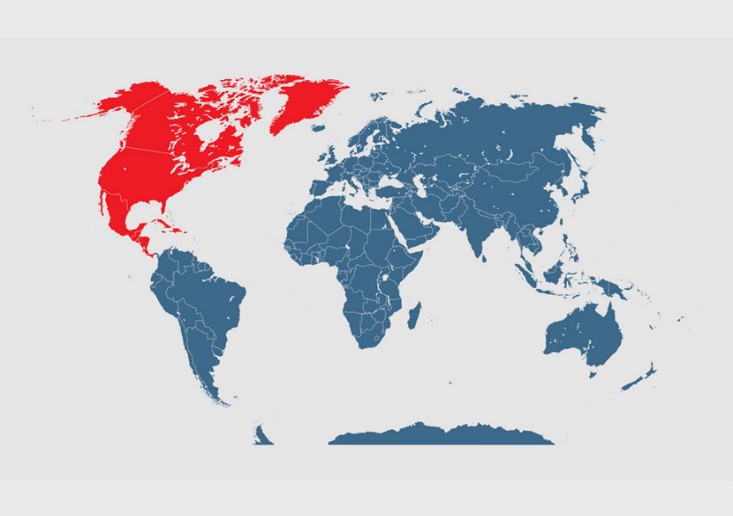Contract Management Software Market Overview
The global contract management software market is experiencing steady growth, driven by the increasing need for efficient management of contracts across industries such as legal, procurement, real estate, and healthcare. This market includes various types of software, such as document management tools, workflow automation, and compliance monitoring systems. Our report provides a comprehensive analysis of procurement trends, focusing on cost optimization strategies and the role of digital tools in streamlining contract creation, execution, and management.
Key future challenges in contract management include managing complex contract terms, ensuring compliance with evolving regulations, and mitigating risks associated with non-compliance. The adoption of digital contract management tools and advanced contract lifecycle management systems is essential for enhancing efficiency, reducing legal risks, and improving overall procurement and operational performance. As the demand for digital solutions grows, companies are leveraging market intelligence to gain insights into procurement opportunities and minimize risks.
The contract management software market is expected to maintain steady growth through 2032, with key highlights including:
- Market Size: The global contract management software market is projected to reach USD 3.8 billion by 2032, growing at a CAGR of approximately 12.80 % from 2024 to 2032.

Growth Rate: 12.80%
- Sector Contributions: Growth in the market is driven by:
- Legal and Compliance Needs: Increasing demand for software solutions to ensure that contracts comply with regulations and industry standards.
- Procurement Efficiency: Rising need for organizations to manage supplier contracts, streamline negotiations, and ensure cost savings through digital tools.
- Technological Transformation and Innovations: Advancements in contract management systems, such as the integration of AI, automation, and blockchain, are improving accuracy, reducing errors, and enhancing contract execution speed.
- Investment Initiatives: Companies are investing in advanced software solutions that offer features like automated contract tracking, approval workflows, and document storage to reduce administrative overhead and increase efficiency.
- Regional Insights: North America remains a significant contributor to the market due to widespread adoption of contract management solutions across various industries.
Key Trends and Sustainability Outlook:
- Increased Digital Integration: The automation of contract drafting, signing, and monitoring is improving efficiency, reducing human errors, and enhancing workflow management.
- Cloud-Based Solutions: The adoption of cloud-based contract management software is increasing due to its scalability, cost-efficiency, and accessibility.
- Focus on Compliance: Companies are placing more emphasis on ensuring that contracts comply with regulatory requirements, helping to avoid legal risks and penalties.
- Data-Driven Contracting: Leveraging big data and analytics to track contract performance, identify potential risks, and optimize the terms of future contracts.
- Sustainability Focus: Increasing demand for environmentally friendly contract management solutions, such as paperless contract signing and cloud storage to reduce environmental impact.
Growth Drivers:
- Legal and Procurement Challenges: Companies are investing in contract management software to streamline contract creation, tracking, and execution, addressing challenges such as contract complexity and compliance.
- Regulatory Compliance: The need to meet increasingly complex regulatory requirements is driving the demand for robust contract management systems.
- Operational Efficiency: Companies are adopting contract management software to increase efficiency, reduce administrative overhead, and optimize contract lifecycle management.
- Risk Management: The rising need to manage risks associated with contract breaches, late payments, and compliance issues is propelling the adoption of contract management software.
- Customization: The growing demand for customizable contract management solutions tailored to specific industry needs, including healthcare, legal, and real estate sectors.
Overview of Market Intelligence Services for Contract Management Software:
Recent analyses have highlighted key challenges such as managing contract complexity, ensuring compliance, and reducing administrative costs. Market intelligence reports offer actionable insights into procurement opportunities, helping organizations optimize vendor management, streamline contract negotiation processes, and enhance supply chain resilience. These reports also assist businesses in identifying cost-saving measures, ensuring compliance, and maintaining high-quality standards across all contracts.
Procurement Intelligence for Contract Management Software: Category Management and Strategic Sourcing:
To remain competitive, companies are optimizing procurement processes using contract management software that helps in contract negotiation, vendor tracking, and improving supply chain efficiency. Effective category management and strategic sourcing are essential for minimizing procurement costs and ensuring a continuous supply of high-quality contracts. By leveraging actionable market intelligence, businesses can refine their procurement strategies and secure the best possible terms for their contract needs.
Pricing Outlook for Contract Management Software: Spend Analysis
The pricing outlook for contract management software is expected to remain relatively stable, with occasional fluctuations influenced by several critical factors. The growing demand for digital solutions, advancements in cloud technology, and the increasing need for compliance and regulatory support across various industries are significant contributors to potential price changes. Additionally, the rise in software customization and integration demands may impact pricing dynamics.
Graph shows general upward trend pricing for contract management software and growing demand. However, there may be fluctuations influenced by economic conditions, technological advancements, and competitive dynamic.
Efforts to enhance software efficiency, reduce manual processes, and integrate advanced technologies such as artificial intelligence, automation, and blockchain are vital for controlling costs. Moreover, adopting scalable cloud-based solutions, which can be tailored to specific industry needs, will help mitigate price increases.
Collaborating with reliable software vendors, promoting continuous innovation, and optimizing software deployment and support channels are essential for managing costs effectively. Despite these challenges, investing in research and development, ensuring robust software security, and adhering to industry standards and regulations will remain crucial for addressing price variations.
Cost Breakdown for Contract Management Software: Total Cost of Ownership (TCO) and Cost-Saving Opportunities

- Software Licensing (35%)
- Description: The primary cost for contract management software includes licensing fees, which are based on the number of users, features, and the scale of the solution. Licensing costs can vary significantly depending on the deployment model, whether cloud-based, on-premise, or hybrid.
- Trends: Rising demand for flexible subscription models and pay-per-user pricing structures is driving the adoption of more cost-efficient licensing plans. Additionally, cloud-based solutions are reducing upfront costs and offering scalable pricing options for businesses of all sizes.
- Labor (XX%)
- Maintenance (XX%)
- Infrastructure & Overheads (XX%)
Cost-Saving Opportunities: Negotiation Levers and Purchasing Strategies
Optimizing procurement strategies and improving software integration processes can yield significant cost savings and operational efficiencies for organizations using contract management software. Establishing long-term agreements with software providers, particularly for multi-year licenses or bulk user purchases, can lead to discounts and reduce the overall cost per user. Strategic collaboration with software vendors can also enable favorable payment terms, custom pricing packages, and volume-based pricing benefits.
Investing in advanced technologies such as automation and AI-driven tools can lower operational costs by streamlining workflows, reducing manual tasks, and improving overall efficiency. Additionally, adopting cloud-based solutions, which offer scalability and flexibility, can help decrease upfront costs while aligning with the organization’s digital transformation goals. Companies can implement diversified sourcing strategies to mitigate risks associated with vendor lock-in, ensuring that they maintain competitive pricing and service levels by keeping options open with multiple providers.
Supply and Demand Overview for Contract Management Software: Demand-Supply Dynamics and Buyer Intelligence for Effective Supplier Relationship Management (SRM)
The contract management software market is expanding due to increasing demand from industries such as legal, procurement, real estate, and healthcare. Supply and demand dynamics are influenced by advancements in technology, changes in legal and compliance regulations, and evolving customer requirements for software solutions.
Demand Factors:
- Legal and Compliance Needs: The increasing complexity of regulatory requirements in sectors like finance, healthcare, and manufacturing is driving demand for contract management solutions that ensure compliance and risk mitigation.
- Procurement Efficiency: Organizations are increasingly adopting contract management software to streamline procurement workflows, reduce administrative overhead, and improve supplier relationships.
- Operational Automation: The shift towards automation and digitalization in business operations is creating a higher demand for solutions that help automate contract drafting, signing, and monitoring processes.
- Data and Reporting Capabilities: The growing need for real-time data, performance metrics, and reporting capabilities is driving demand for more sophisticated contract management software with advanced analytics features.
Supply Factors:
- Technological Advancements: Innovations in AI, machine learning, and blockchain are enhancing the capabilities of contract management software, making it more efficient, secure, and user-friendly.
- Cloud Solutions: The rise of cloud-based contract management software has expanded supply capabilities by offering scalable, cost-effective, and easily accessible solutions for businesses of all sizes.
- Vendor Competition: Increased competition among software vendors has resulted in better pricing, improved product features, and enhanced customer support, giving buyers more options and greater negotiating power.
- Integration Capabilities: The ability of contract management software to seamlessly integrate with other enterprise systems (e.g., ERP, CRM) is improving the overall software supply and helping businesses optimize contract processes.
Regional Demand-Supply Outlook: Contract Management Software
The Image shows growing demand for contract management software in both North America and Asia Pacific, with potential price increases and increased Competition.
North America: Dominance in Contract Management Software
North America remains a dominant player in the Canada, United States contract management software market, driven by:
- Regulatory Compliance: Stringent regulations in industries such as finance, healthcare, and manufacturing are pushing the demand for sophisticated contract management solutions to ensure compliance.
- Digital Transformation: The adoption of digital tools and software solutions in businesses across various sectors, particularly in the legal and procurement industries, is fuelling the need for advanced contract management systems.
- Focus on Security and Data Protection: The emphasis on data security and protection, particularly in North American industries like finance and healthcare, is increasing the demand for secure contract management software with robust compliance features.
- Innovation in Automation: The increasing focus on automation to streamline contract creation, negotiation, and execution is pushing demand for software solutions that integrate with other business systems and support efficient contract lifecycle management.
North America Remains a key hub contract management software price drivers Innovation and Growth.
Supplier Landscape: Supplier Negotiations and Strategies
The supplier landscape for contract management software is highly dynamic, with a blend of established global vendors and emerging regional players shaping the market. These suppliers influence pricing, technological innovations, and the availability of sophisticated software solutions tailored to various industries. The market is competitive, with major players dominating while smaller companies are gaining ground by offering specialized solutions for legal, procurement, and compliance management.
The current supplier landscape in the contract management software market is characterized by innovation and strategic partnerships. Leading global software providers hold a significant market share, while smaller firms continue to expand by addressing niche requirements such as AI-powered contract analysis, blockchain integration, and industry-specific compliance features.
Key suppliers in the Contract Management Software market:
- SAP Ariba
- DocuSign
- Icertis
- Coupa Software
- Zycus
- Agi loft
- Contract Works
- Onit
- Ironclad
- Oracle Procurement Cloud

Key Developments Procurement Category Significant Development:
|
Significant Development |
Description |
|
Market Growth |
The global contract management software market is expanding due to increasing demand across industries such as legal, procurement, healthcare, and manufacturing. |
|
Sustainable Practices |
There is a growing adoption of eco-friendly features in contract management software, including paperless workflows and compliance with environmental regulations. |
|
Product Diversification |
Software solutions are becoming more diversified, offering features tailored to specific industries, such as legal document automation, compliance tracking, and vendor management. |
|
Technological Innovations |
Advancements in AI, machine learning, and blockchain are enhancing contract management capabilities, improving efficiency, security, and contract lifecycle automation. |
|
E-commerce Expansion |
Online platforms and cloud-based solutions are making contract management software more accessible to businesses of all sizes, improving distribution and global reach. |
|
Focus on Automation |
The increasing demand for automation in contract creation, approval, and execution is driving innovation in contract management systems, leading to greater operational efficiency. |
|
Regional Manufacturing Hubs |
The growth of regional service centers and cloud infrastructures in North America, Europe, and Asia is strengthening global support networks and enhancing software accessibility. |
|
Contract Management Software Attribute/Metric |
Details |
|
Contract Management Software Market Size |
The global contract management software market is projected to reach USD 3.8 billion by 2032, growing at a CAGR of approximately 12.80 % from 2024 to 2032. |
|
Technology Contract Management Software Adoption Rate |
Approximately 45% of organizations are adopting advanced technologies such as AI, automation, and cloud-based solutions to streamline contract processes and enhance efficiency. |
|
Top Contract Management Software Strategies for 2024 |
Focus on improving automation, integrating AI-driven contract analysis, and enhancing user experience while emphasizing data security and compliance features. |
|
Automation in Contract Management Software Processes |
Around 35% of companies are using automation in contract creation, approval workflows, and e-signatures to reduce administrative overhead and increase speed. |
|
Challenges in Contract Management Software Management |
Major challenges include managing complex regulatory requirements, mitigating contract risks, ensuring compliance, and dealing with manual, paper-based processes. |
|
Key Suppliers |
Leading contract management software providers include SAP Ariba, DocuSign, Icertis, and Coupa Software, serving industries such as legal, procurement, and manufacturing. |
|
Key Regions Covered |
Key regions include North America, Europe, and Asia Pacific, where demand for contract management solutions is high in industries such as legal, procurement, and healthcare. |
|
Market Drivers and Trends |
Growth is driven by increasing demand for automation in contract workflows, the shift to cloud-based platforms, enhanced regulatory compliance needs, and a focus on data security and integration with other enterprise systems. |
Frequently Asked Questions (FAQ):
Our procurement intelligence services provide comprehensive market insights, identifying top contract management software vendors and analysing industry trends. We offer detailed cost breakdowns, supplier performance evaluations, and tailored sourcing strategies to ensure cost-effective and reliable procurement.
We assist in assessing the TCO by evaluating licensing fees, implementation costs, ongoing support and maintenance, and potential training expenses. This approach provides a complete financial view of procurement decisions for contract management solutions.
Our risk management strategies focus on minimizing risks such as vendor performance issues, software security vulnerabilities, and changes in compliance requirements. We help ensure a stable and compliant software solution while managing potential procurement risks.
Our Supplier Relationship Management (SRM) services focus on building strong partnerships with software providers through effective contract negotiation, performance tracking, and service level agreement (SLA) management to ensure continuous support and cost efficiencies.
Best practices include conducting thorough vendor evaluations, comparing software features and prices, ensuring compliance with business requirements, and aligning the procurement strategy with long-term organizational goals to optimize contract management.
Digital transformation enhances procurement by automating the contract lifecycle, improving data accessibility, and utilizing real-time analytics to streamline decision-making. This reduces manual errors, improves efficiency, and offers better oversight of contract performance.
Monitoring supplier performance ensures that the contract management software meets agreed-upon standards such as system uptime, support responsiveness, and feature enhancements, ensuring the software aligns with business needs and expectations.
Using market intelligence, comparing vendor offers, and identifying opportunities for long-term contracts or bulk purchases allows us to support negotiations that secure favourable pricing, licensing terms, and added benefits like free upgrades or extended support.
Our market analysis tools provide valuable insights into pricing models, vendor capabilities, software features, industry-specific needs, and competitive trends, helping you make informed procurement decisions based on real-time data.
We review vendor compliance with industry standards, legal requirements, and data protection regulations, ensuring that the software solution aligns with your organization’s compliance framework and meets necessary legal and regulatory standards.
Strategies include selecting vendors with strong contingency plans, maintaining flexible contract terms, and ensuring access to support services to address potential disruptions in software updates or support.
Our tools track key performance indicators such as software functionality, response times, issue resolution, and system uptime, ensuring long-term supplier relationships and continuous software optimization.
Sustainable procurement involves choosing software providers that prioritize eco-friendly data centers, energy-efficient operations, and paperless processes, ensuring that the procurement aligns with your organization's environmental goals.
Our pricing analysis services evaluate different vendor offers, track market trends, and help identify opportunities for cost savings, ensuring that the selected software solution provides the best value without compromising on quality or service.








